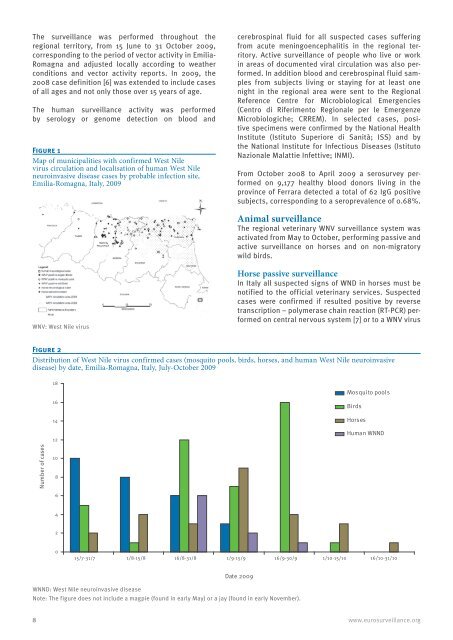Vector-borne diseases - Eurosurveillance
Vector-borne diseases - Eurosurveillance
Vector-borne diseases - Eurosurveillance
You also want an ePaper? Increase the reach of your titles
YUMPU automatically turns print PDFs into web optimized ePapers that Google loves.
The surveillance was performed throughout the<br />
regional territory, from 15 June to 31 October 2009,<br />
corresponding to the period of vector activity in Emilia-<br />
Romagna and adjusted locally according to weather<br />
conditions and vector activity reports. In 2009, the<br />
2008 case definition [6] was extended to include cases<br />
of all ages and not only those over 15 years of age.<br />
The human surveillance activity was performed<br />
by serology or genome detection on blood and<br />
Figure 1<br />
Map of municipalities with confirmed West Nile<br />
virus circulation and localisation of human West Nile<br />
neuroinvasive disease cases by probable infection site,<br />
Emilia-Romagna, Italy, 2009<br />
WNV: West Nile virus<br />
cerebrospinal fluid for all suspected cases suffering<br />
from acute meningoencephalitis in the regional territory.<br />
Active surveillance of people who live or work<br />
in areas of documented viral circulation was also performed.<br />
In addition blood and cerebrospinal fluid samples<br />
from subjects living or staying for at least one<br />
night in the regional area were sent to the Regional<br />
Reference Centre for Microbiological Emergencies<br />
(Centro di Riferimento Regionale per le Emergenze<br />
Microbiologiche; CRREM). In selected cases, positive<br />
specimens were confirmed by the National Health<br />
Institute (Istituto Superiore di Sanità; ISS) and by<br />
the National Institute for Infectious Diseases (Istituto<br />
Nazionale Malattie Infettive; INMI).<br />
From October 2008 to April 2009 a serosurvey performed<br />
on 9,177 healthy blood donors living in the<br />
province of Ferrara detected a total of 62 IgG positive<br />
subjects, corresponding to a seroprevalence of 0.68%.<br />
Animal surveillance<br />
The regional veterinary WNV surveillance system was<br />
activated from May to October, performing passive and<br />
active surveillance on horses and on non-migratory<br />
wild birds.<br />
Horse passive surveillance<br />
In Italy all suspected signs of WND in horses must be<br />
notified to the official veterinary services. Suspected<br />
cases were confirmed if resulted positive by reverse<br />
transcription – polymerase chain reaction (RT-PCR) performed<br />
on central nervous system [7] or to a WNV virus<br />
Figure 2<br />
Distribution of West Nile virus confirmed cases (mosquito pools, birds, horses, and human West Nile neuroinvasive<br />
disease) by date, Emilia-Romagna, Italy, July-October 2009<br />
Number of cases<br />
18<br />
16<br />
14<br />
12<br />
10<br />
8<br />
6<br />
4<br />
2<br />
0<br />
15/7-31/7 1/8-15/8 16/8-31/8 1/9-15/9 16/9-30/9 1/10-15/10 16/10-31/10<br />
Date 2009<br />
WNND: West Nile neuroinvasive disease<br />
Note: The figure does not include a magpie (found in early May) or a jay (found in early November).<br />
Mosquito pools<br />
8 www.eurosurveillance.org<br />
Birds<br />
Horses<br />
Human WNND

















